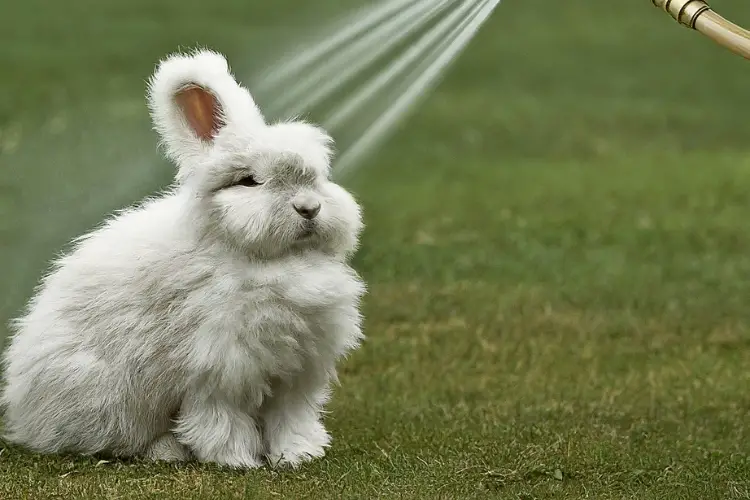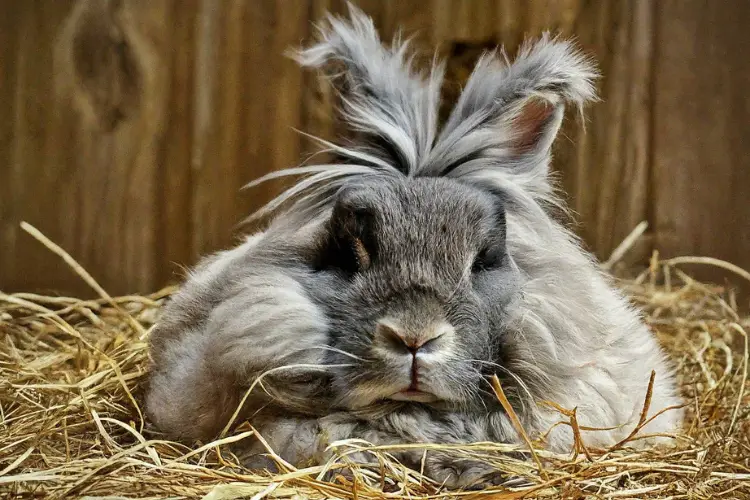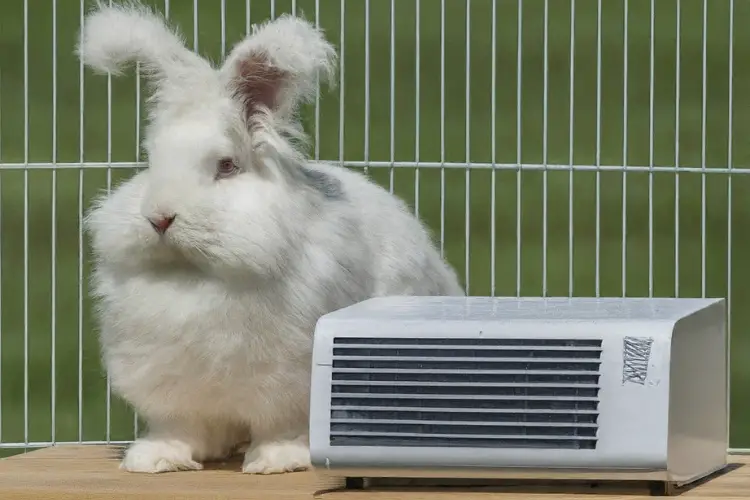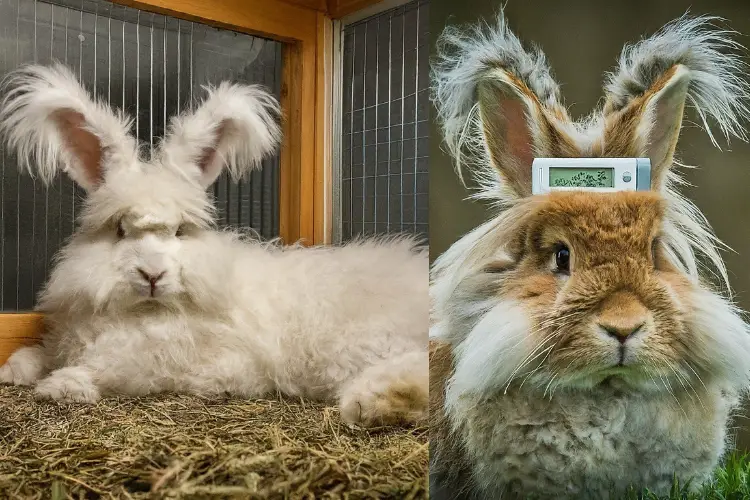Angora rabbits are truly unique creatures, known for their exceptional, long and remarkably dense wool coats. However, this same dense fur that makes them so endearing also means they have very specialized thermal needs compared to other rabbit breeds.
Maintaining the ideal temperature range is absolutely vital for the health, well-being and optimal wool production of these delicate animals. As responsible Angora rabbit owners, understanding and meeting their precise temperature requirements is a crucial part of providing the best possible care.
In this blog post guide, we’ll dive deep into the thermal sensitivities of Angora rabbits, detailing the dangers of overheating, the recommended temperature range, and practical strategies for keeping your beloved bunny comfortable year-round.
By the end, you’ll have all the knowledge necessary to ensure your Angora rabbit thrives in a temperature-controlled environment tailored to their unique needs.
Angora Rabbits and Thermoregulation
a. Understanding How Angora Rabbits Manage Temperature
Unlike humans who rely on sweating to regulate body temperature, rabbits lack sweat glands and instead depend on other mechanisms to stay cool.
Their primary method of heat dissipation is through their large, thin ears, which are filled with blood vessels close to the skin’s surface. When temperatures rise, rabbits will reflexively increase blood flow to these ears, allowing excess body heat to be released.
Angora rabbits, with their exceptionally dense and insulating wool coats, face unique thermoregulatory challenges compared to other rabbit breeds. Their thick fur acts as an effective barrier, trapping heat close to the body and making it difficult for them to shed excess warmth. This can lead to serious issues if their environment is not carefully monitored and controlled.
b. The Dangers of Overheating
Heat stress is a grave concern for Angora rabbits and can have devastating consequences if not addressed promptly. Prolonged exposure to high temperatures can result in a range of health problems, including:
1. Illness and lethargy: Heat-stressed rabbits may become lethargic, refuse to eat, and exhibit signs of general illness.
2. Heatstroke: In extreme cases, Angora rabbits can suffer life-threatening heatstroke, leading to organ failure and death if left untreated.
3. Wool block: The dense, insulating wool coat of Angora rabbits can become matted and tangled when they overheat, trapping heat and further exacerbating the problem.
c. Signs of Overheating in Angora Rabbits
It’s crucial for Angora rabbit owners to be vigilant in monitoring their pets for signs of heat stress. Some key indicators that your rabbit may be overheating include:
- Rapid, shallow breathing or panting
- Lethargy and reluctance to move
- Splayed legs in an attempt to dissipate heat
- Fur that feels warm to the touch
- Lack of appetite or refusal to eat
Recognizing these warning signs early can make the difference between a manageable situation and a potentially life-threatening emergency.

The Ideal Temperature Range
a. The Sweet Spot
The ideal temperature range for Angora rabbits is between 60°F and 75°F (15°C to 24°C). This encompasses the comfortable zone where they can maintain their body temperature without excessive effort or risk of overheating.
b. Seasonal Considerations
While the 60-75°F (15-24°C) range serves as the general guideline, Angora rabbit owners need to be mindful of seasonal temperature fluctuations and make appropriate adjustments.
During the warmer months, aim to keep your rabbit’s environment on the cooler side of the spectrum, closer to 60-65°F (15-18°C). This will help prevent heat stress and allow them to better regulate their body temperature.
Conversely, in the colder winter months, you may need to raise the temperature slightly, towards the upper end of the 60-75°F (15-24°C) range, to ensure your Angora rabbit stays warm and comfortable.
d. Humidity Matters
Ambient humidity levels can also impact an Angora rabbit’s thermal comfort. High humidity environments can make it more difficult for rabbits to cool themselves through ear vasodilation, as the air is already saturated with moisture. Ideally, maintain humidity levels between 40-60% to optimize your rabbit’s ability to thermoregulate.

Strategies for Maintaining Optimal Temperatures
a. Indoor Housing Advantages
For Angora rabbit owners, keeping these delicate bunnies indoors provides the best opportunity to maintain their ideal temperature range. A climate-controlled home environment allows for precise temperature and humidity regulation, shielding your rabbit from the unpredictable and potentially dangerous fluctuations of the great outdoors.
b. Outdoor Housing Risks and Exceptions
While an indoor setup is generally the safest and most reliable option, there may be rare instances where outdoor housing for Angora rabbits can be considered. This, however, requires extensive precautions and careful monitoring, as the risks of overheating or hypothermia are exponentially higher.
If you do opt for an outdoor enclosure, it must be located in a shaded, well-ventilated area, with ample insulation and cooling mechanisms in place to protect your rabbit from extreme heat or cold. Supplement this with frequent temperature checks and close observation of your rabbit’s behavior and physical state.
c. Cooling Techniques
In the quest to keep Angora rabbits comfortable, a variety of effective cooling strategies can be employed:
- Frozen water bottles or ice packs placed in their living space
- Strategically placed fans to increase air circulation
- Use of air conditioning units to regulate ambient temperature
- Cool, damp tiles or mats for them to lie on
- Providing ample fresh, cool water at all times
d. Warming Techniques
While protecting Angora rabbits from heat is a primary concern, owners must also be prepared to keep them warm during colder months. Useful warming methods include:
- Offering extra bedding and nesting materials
- Providing safe, thermostatically-controlled heating sources
- Ensuring adequate insulation in their living quarters
By combining cooling and warming techniques as needed, you can create a comfortable, temperature-stable environment for your Angora rabbit year-round.

Beyond the Numbers: Monitoring Your Rabbit’s Comfort
a. Individual Variances
It’s important to note that, like humans, individual Angora rabbits may have slightly different tolerances to temperature extremes. Some may be more resilient to heat, while others may be more sensitive. Closely observing your rabbit’s reactions and making adjustments accordingly is crucial.
b. Behavioral Cues
In addition to monitoring temperature and humidity levels, it’s essential to watch for behavioral signs that your Angora rabbit may be experiencing discomfort. These can include:
- Lethargy or reluctance to move
- Panting or rapid, shallow breathing
- Sprawling out with limbs extended to dissipate heat
- Lack of appetite or refusal to eat
Paying close attention to your rabbit’s body language and activity levels can provide invaluable insights into their thermal comfort, allowing you to make timely adjustments.
c. Importance of Proactive Measures
When it comes to Angora rabbit temperature regulation, prevention is key. Reacting to heat stress or cold discomfort after the fact can be risky and challenging. By being proactive and maintaining their ideal temperature range at all times, you can safeguard your rabbit’s health and well-being, and enjoy a happy, thriving companion.
Special Considerations
a. Grooming’s Role
Regular, thorough grooming plays a vital role in maintaining an Angora rabbit’s thermal comfort. Removing excess, matted fur through brushing and trimming helps improve air circulation and prevent heat buildup within their dense coat. This simple yet essential grooming routine can significantly enhance their ability to regulate their body temperature.
b. Senior Rabbits and Increased Sensitivity
As Angora rabbits age, they may become more sensitive to temperature extremes. Older rabbits may have a narrower tolerance range and require even more vigilant temperature monitoring and control. Owners of senior Angora rabbits should be especially attentive to any signs of heat or cold stress and make adjustments accordingly.
Conclusion
Angora rabbits, with their exquisite and insulating wool coats, have very specific thermal needs that must be prioritized for their health and well-being.
By understanding the dangers of overheating, the recommended temperature range, and practical strategies for maintaining optimal conditions, Angora rabbit owners can create a comfortable environment that allows these delicate creatures to thrive.
Responsible Angora rabbit ownership is about far more than just admiring their soft, fluffy coats – it’s about diligently monitoring their temperature, watching for signs of distress, and taking proactive measures to keep them in their ideal comfort zone. With the knowledge gained from this comprehensive guide, you can confidently provide your Angora rabbit with the temperature-controlled care they require, ensuring a long, happy and healthy life together.

